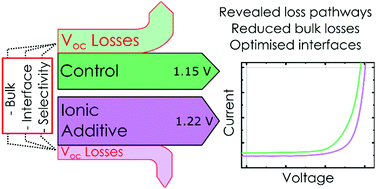Understanding and suppressing non-radiative losses in methylammonium-free wide-bandgap perovskite solar cells†
Abstract
With power conversion efficiencies of perovskite-on-silicon and all-perovskite tandem solar cells increasing at rapid pace, wide bandgap (>1.7 eV) metal-halide perovskites (MHPs) are becoming a major focus of academic and industrial photovoltaic research. Compared to their lower bandgap (≤1.6 eV) counterparts, these types of perovskites suffer from higher levels of non-radiative losses in both the bulk material and in device configurations, constraining their efficiencies far below their thermodynamic potential. In this work, we investigate the energy losses in methylammonium (MA) free high-Br-content wide bandgap perovskites by using a combination of THz spectroscopy, steady-state and time-resolved photoluminescence, coupled with drift-diffusion simulations. The investigation of this system allows us to study charge-carrier recombination in these materials and devices in the absence of halide segregation due to the photostabilty of formamidinium-cesium based lead halide perovskites. We find that these perovskites are characterised by large non-radiative recombination losses in the bulk material and that the interfaces with transport layers in solar cell devices strongly limit their open-circuit voltage. In particular, we discover that the interface with the hole transport layer performs particularly poorly, in contrast to 1.6 eV bandgap MHPs which are generally limited by the interface with the electron-transport layer. To overcome these losses, we incorporate and investigate the recombination mechanisms present with perovskites treated with the ionic additive 1-butyl-1-methylpipiderinium tetrafluoroborate. We find that this additive not only improves the radiative efficiency of the bulk perovskite, but also reduces the non-radiative recombination at both the hole and electron transport layer interfaces of full photovoltaic devices. In addition to unravelling the beneficial effect of this specific treatment, we further optimise our solar cells by introducing an additional LiF interface treatment at the electron transport layer interface. Together these treatments enable MA-free 1.79 eV bandgap perovskite solar cells with open-circuit voltages of 1.22 V and power conversion efficiencies approaching 17%, which is among the highest reported for this material system.

- This article is part of the themed collection: Materials for energy storage and conversion: Chemical Science symposium collection


 Please wait while we load your content...
Please wait while we load your content...